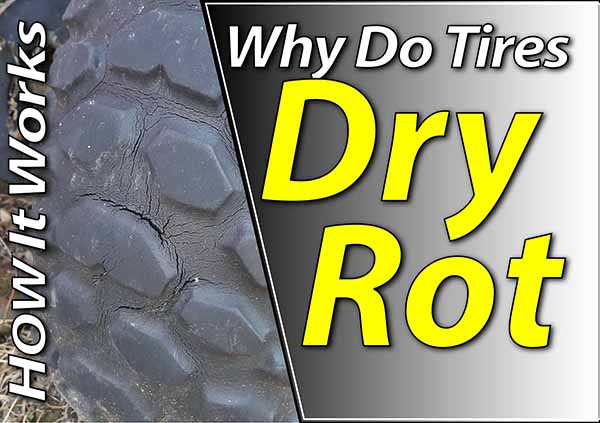Dry rot on tires, a frustrating ailment for car owners, manifests as brittle, cracked rubber sidewalls. While these fissures may not seem significant at first, they pose a grave threat to tire integrity, leading to blowouts and potentially hazardous driving situations. Fortunately, discerning the signs of dry rot and applying appropriate repair techniques can help you remedy this issue effectively and ensure the longevity of your tires.

Image: tirehubz.com
Recognizing the Signs: Dry Rot’s Telltale Indicators
Understanding the symptoms of dry rot is crucial to determining the severity of the damage and implementing the necessary steps for repair. Dry rot primarily affects the sidewalls of tires, where the amalgamation of rubber and steel cords creates a vulnerable area. The characteristic signs of dry rot include:
-
Cracking and Fissures: Noticeable superficial cracks appear across the tire sidewalls, resembling spider webbing or alligator skin. These cracks progressively deepen with time, exposing the internal layers of the tire.
-
Bulges and Deformations: As dry rot weakens the tire’s structure, bulges and deformations may emerge on the sidewalls, indicating weakened cords and a potential blowout risk. These irregularities disrupt the tire’s balance and handling capabilities.
-
Tire Discoloration: UV rays and ozone exposure contribute to the breakdown of tire rubber, causing discoloration in the affected areas. Initially, these patches appear as greyish or whitish areas, gradually darkening as the dry rot worsens.
Delving into the Causes: Uncovering the Factors Leading to Dry Rot
Understanding the underlying factors leading to dry rot empowers you with the knowledge to prevent this issue from recurring in the future. The primary culprits of dry rot are often prevalent within day-to-day driving conditions:
-
Exposure to the Elements: Tires endure harsh weather conditions, including exposure to UV rays, ozone, and fluctuating temperatures. These environmental elements trigger chemical reactions in the rubber, causing it to break down and lose its flexibility.
-
Underinflation: Maintaining proper tire pressure is essential for tire health. Underinflated tires take on a wider surface contact area, increasing the amount of friction between the tire and road. This excess friction generates more heat, accelerating rubber degradation.
-
Improper Storage: When tires are piled up or inadequately protected from sunlight and moisture, dry rot can set in more rapidly. Proper storage techniques, such as keeping tires in a cool, dry place away from direct sunlight, can extend their lifespan.
-
Tire Age: Tires have a finite lifespan, and as they age, their susceptibility to dry rot increases. This age-related degradation occurs naturally due to the gradual breaking down of rubber compounds over time.
Tackling Dry Rot: A Guide to Effective Repair Techniques
While repairing dry rotted tires is not a simple task, it can be effectively accomplished by skilled professionals with the right tools and expertise. Here’s a practical guide to repairing dry rotted tires:
-
Assessment of Damage: Before commencing repair work, a thorough inspection is necessary to gauge the extent of the dry rot damage. Determining the severity of cracks, bulges, and discoloration will dictate the appropriate repair method.
-
Trimming Affected Areas: In cases of superficial cracks, cautiously trimming the affected areas with a sharp knife can eliminate weakened rubber and pave the way for a better repair bond.
-
Vulcanization Application: Vulcanization is a process that utilizes heat and pressure to merge new rubber material with the existing tire. Damaged areas are treated with a vulcanizing agent, followed by the application of heat and pressure to fuse the materials.
-
Tread Repair: If dry rot has compromised the tire’s tread, professional tread repair is essential. Trained technicians employ specialized equipment to replace worn or damaged tread, restoring the tire’s performance capabilities.
-
Tire Replacement: In severe cases where dry rot has significantly weakened the tire’s structure or if the cracks are deep or extensive, tire replacement is the only viable solution. This ensures the utmost safety and eliminates the risk of a potential blowout.

Image: cargearguru.com
Preventive Measures: Shielding Tires from Dry Rot’s Grip
Protecting your tires from the onslaught of dry rot is a proactive measure that will save you time, money, and potentially dangerous tire failures. By incorporating these preventive steps into your tire maintenance routine, you can significantly reduce the risk of dry rot:
-
Keep Tires Properly Inflated: Always adhere to the recommended tire pressure for your vehicle. Consistent inflation not only enhances tire performance but also minimizes uneven wear and, consequently, the onset of dry rot.
-
Shield from the Elements: Grant your tires refuge from direct sunlight, rain, and snow by incorporating a protective sealant or dressing. These products establish a defensive barrier, safeguarding the rubber against harsh environmental elements.
-
Store Tires Properly: When not in use, tires should be nestled away from harsh conditions. Keep them in a dry, dark, climate-controlled environment or consider investing in specialized tire covers.
-
Maintain Optimal Tire Usage: Rotate your tires regularly according to the manufacturer’s guidelines. This practice guarantees even wear across all tires, preventing localized stress and subsequent dry rot formation.
How To Fix Dry Rotted Tires
https://youtube.com/watch?v=t7jjdO19TNI
Seeking Professional Assistance: Enlisting the Expertise of Tire Experts
If you witness symptoms of dry rot on your tires, don’t hesitate to consult a knowledgeable tire professional. They possess the expertise to accurately evaluate the severity of the damage and determine the most appropriate repair or replacement solution for your vehicle. Their insights will ensure your tires are restored to optimal condition, ensuring secure driving for years to come.
By understanding the causes, recognizing the symptoms, and implementing effective repair techniques